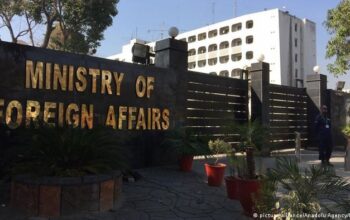By Staff Reporter
Fitch Ratings lifted Pakistan’s Long-Term Foreign-Currency Issuer Default Rating to ‘B-’ from ‘CCC+’, with a Stable Outlook, signalling cautious hope for economic stabilisation via a $7 billion IMF Extended Fund Facility and $1.3 billion Resilience Facility.
Is this a turning point for a country scarred by fiscal turmoil and political chaos, or a fleeting pause in a storm of structural challenges?
The upgrade signals some tangible improvements in economic fundamentals, fuelling optimism among investors and policymakers alike.
The agency points to “increased confidence that Pakistan will sustain its recent progress on narrowing budget deficits and implementing structural reforms.” This isn’t empty praise—data backs it up.
The government is curbing excess. Fitch sees the budget deficit shrinking to 6 percent of GDP in FY25 (ending June 2025) from nearly 7 percent in FY24, with a medium-term target of 5 percent.
The primary surplus, a key IMF metric, is set to more than double to over 2 percent of GDP, aided by a one-off 2 percent GDP State Bank of Pakistan (SBP) dividend—a crutch highlighting reliance on temporary fixes.
Debt-to-GDP dropped to 67 percent in FY24 from 75 percent, driven by tight fiscal policy and lower-rate domestic debt, yet it’s high versus the ‘B’ median (50 percent), with a brief FY25 uptick due to low inflation.
Fitch expects the trend to continue, driven by “tight fiscal policy, nominal growth, and a repricing of domestic debt at lower rates.” For a country where debt has long been a millstone, this trajectory suggests a lighter burden over time.
Interest payments, gobbling 59 percent of revenue in FY25 (against a ‘B’ median of 13 percent), however, expose costly domestic debt and a weak revenue base, choking flexibility.
On the external front, Pakistan is showing unexpected strength. A current account surplus of $700 million in the first eight months of FY25, fuelled by surging remittances and lower import costs, marks a stark contrast to years of deficits.
Gross reserves reached $18 billion by March 2025, covering three months of payments—up from $8 billion in early 2023—though net reserves are less rosy due to commercial deposits and bilateral loans.
Fitch expects more gains via SBP forex buys. This buffer reduces the risk of a balance-of-payments crisis, a spectre that has haunted Pakistan for decades.
The IMF’s role cannot be overstated. A March 2025 agreement for its programs’ first review shows reform resolve. Fitch highlights Pakistan’s “strong performance on quantitative performance criteria,” including reserve accumulation and fiscal targets, even if tax revenues fell short. Structural benchmarks, like provincial agricultural income tax hikes, are being met, building on the momentum of a prior IMF arrangement that ended in April 2024. With $4 billion secured in external financing in 1HFY25 and $10 billion expected in 2HFY25 (including $5 billion from Chinese banks), Pakistan’s funding gap looks manageable—for now. But IMF-mandated reforms strain capacity, with revenue weaknesses glaring.
Inflation, once a crippling force at over 20 percent in FY23-FY24, is projected to average just 5 percent in FY25, thanks to fading energy price shock effects. GDP growth, while modest at 3 percent, signals a recovery from recent stagnation. The SBP’s decision to hold its policy rate at 12 percent after 1,000 basis points of cuts reflects a balancing act—supporting growth while guarding against inflation’s return (Fitch expects 8 percent in FY26).
These metrics undoubtedly paint a picture of a country finally getting its house in order. Investors may see ‘B-’ as a green light to explore Pakistani bonds, especially with a Stable Outlook suggesting no immediate downgrade risk. The government, led by Prime Minister Shehbaz Sharif, can point to the upgrade as validation of its tough reforms, potentially strengthening its hand domestically.
But the upgrade also reveals cracks that could undermine Pakistan’s progress. Fitch itself tempers its enthusiasm, warning that “implementation risks remain and financing needs are still large.”
While the debt-to-GDP ratio is down, it’s still high at 67 percent—well above the ‘B’ median of 50 percent. Fitch notes a temporary uptick in FY25 due to lower inflation, which erodes nominal GDP growth. More concerning is the interest payment-to-revenue ratio, forecast at a staggering 59 percent in FY25, dwarfing the ‘B’ median of 13 percent. This reflects Pakistan’s heavy reliance on costly domestic debt and a narrow revenue base. “The lagged effects of high domestic interest rates in recent years still weigh on fiscal performance,” Fitch observes, suggesting that debt servicing will continue to choke fiscal flexibility.
The SBP extraordinary dividend transfer of 2 percent of GDP to the government in FY25, a byproduct of earlier aggressive rate hikes, highlights the reliance on one-off fiscal fixes rather than durable revenue reforms. While provincial agricultural tax legislation meets an IMF structural benchmark, implementation risks loom, particularly given Pakistan’s history of backtracking on politically sensitive reforms.
The country’s external position, while improved, is far from secure. The country faces $8 billion in debt maturities in FY25 ($5 billion in 2HFY25) and $9 billion in FY26, excluding $13 billion in bilateral rollovers that aren’t guaranteed forever. The next international bond maturity in September 2025 looms large. Fitch acknowledges that “market turmoil could still reduce access to loan funding,” especially if global trade tensions—potentially hurting Pakistan’s textile exports to the US (3 percent of GDP)—escalate. Even the reserve buildup is less impressive when you consider net reserves, which are lower due to commercial bank deposits, a Chinese swap line, and bilateral loans at the SBP.
Domestically, it’s perilous. Sharif’s coalition, despite military backing, secured a weaker-than-expected mandate in 2024 elections. The imprisoned former Prime Minister Imran Khan remains a potent force, fuelling polarization. Security incidents along the Afghan border and in Balochistan are rising, complicating governance.
Fitch warns of Pakistan’s “mixed record of IMF programme performance,” noting that “the current apparent consensus within Pakistan on the need for reform could weaken over time.” If political will falters, reforms could stall, as they have in the past.
The IMF lifeline comes with strings—tough structural reforms that test Pakistan’s resolve. Tax revenue shortfalls, partly due to lower inflation and imports, highlight weak fiscal capacity. Fitch’s forecast of a 5 percent medium-term deficit assumes sustained discipline, but history suggests otherwise.
“Governments from across the political spectrum in Pakistan have often failed to implement or reversed the required reforms,” Fitch cautions. Technical challenges, like modernizing tax systems or cutting subsidies, could trip up even a willing administration.
Pakistan’s low export dependence (textiles aside) and stable remittances from the Middle East offer some insulation, but global risks—like tariffs and trade wars or commodity price swings—could still hit hard. Fitch notes that “international trade tensions could hurt Pakistan’s goods exports,” and while lower oil prices help, any reversal could strain the trade balance.
The ‘B-’ rating feels like a generous pat on the back. Investors, however, might hesitate, knowing Pakistan’s history of boom-and-bust cycles. The Stable Outlook could easily shift if external shocks or domestic missteps erode confidence. For investors, the upgrade lowers perceived risk, potentially making Pakistani debt more attractive, especially with reserves and IMF backing providing a safety net. But the high interest-to-revenue ratio and looming maturities warrant caution—Pakistan isn’t a “buy” without due diligence.
For policymakers, the rating is both a carrot and a stick. It validates reforms but demands consistency. Sharif’s government must navigate political opposition and security threats while delivering on IMF pledges, all without alienating a restive public. For Pakistanis, the upgrade offers little immediate relief. Lower inflation (5 percent) is a bright spot, but growth (3 percent) remains sluggish, and debt servicing crowds out social spending. The IMF’s austerity measures could fuel discontent, especially if reforms like tax hikes hit hard.
Fitch’s upgrade rewards Islamabad’s technocratic progress but does little to resolve Pakistan’s existential challenges. The economy remains trapped in a cycle of low growth, high debt servicing, and reliance on fickle external financing. While the ‘B-’ rating signals reduced near-term default risk, this isn’t a clean bill of health—it’s a conditional vote of confidence. The message is clear: Pakistan’s reforms are a story of survival, not transformation.
Copyright © 2021 Independent Pakistan | All rights reserved




